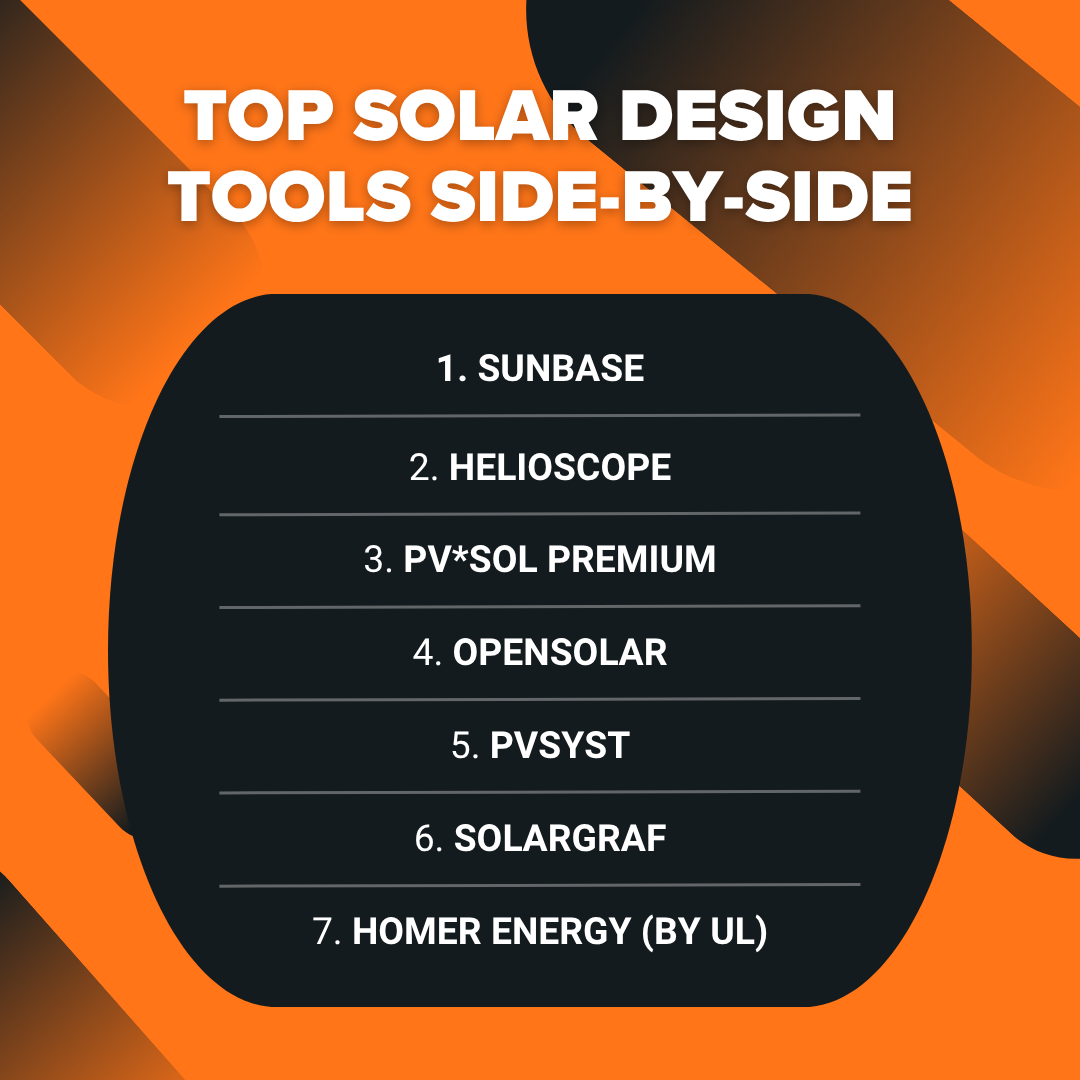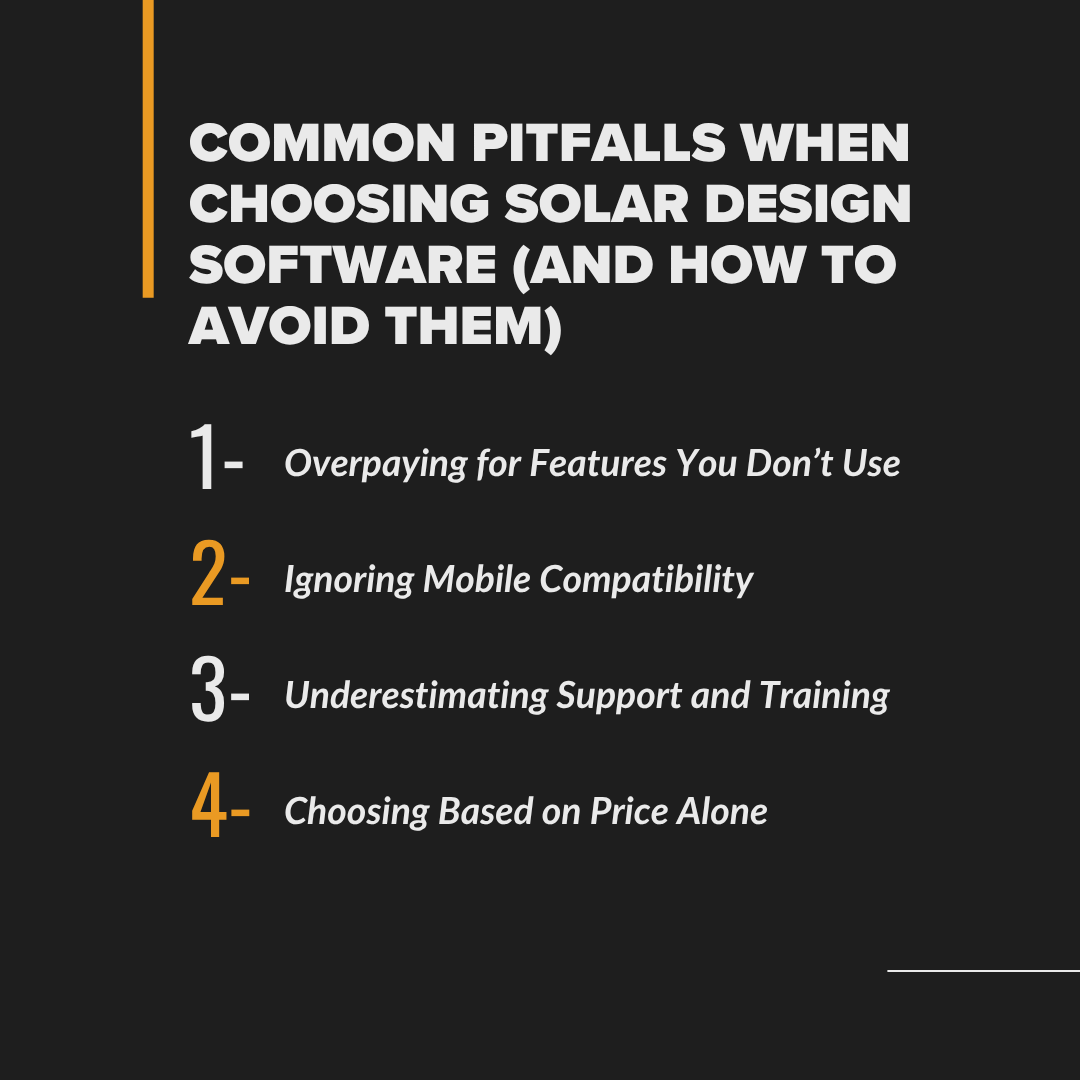September 19, 2025
Audio overview: Listen & Learn
Solar installers using solar design software face various challenges, including temperature, soiling, shading, and reflection, all of which can result in a decrease in the performance of solar installations.
Example: Last quarter, a promising solar startup missed out on three big deals. The reason? Delays in their design turnaround time. In a fast-moving solar industry, even minor lags in proposal generation or system design can cost you clients.
Solar professionals today are under immense pressure to design faster, present smarter, and deliver accurate
system projections, without stretching their already limited resources.
That’s where solar design software comes in. But with so many options out there, how do you decide what’s best for your business?
Best Solar Design Software in 2025: Side-by-Side Comparison of Features & Pricing
Studies indicate that solar projects that utilize advanced solar design software generally attain annual return on investment (ROI) rates ranging from 10% to 22% for residential and commercial systems. Consequently, it's crucial to determine which solutions align best with your specific requirements.
This guide breaks it down clearly. We’ve researched, compared, and reviewed the top-performing solar design software tools to help you make a smart, confident decision, without the sales fluff.
Whether you’re just launching your solar company, looking to upgrade your tool stack, or need to fix inefficiencies in your current workflow, this article is for you.
Key Takeaways:
- Solar design software simplifies the process of creating accurate layouts, energy production estimates, and proposals.
- The right software can increase close rates by shortening sales cycles and providing professional proposals.
- Advanced features like shading analysis, 3D modeling, and financial projections give a competitive edge.
- Choosing software that fits your team size, budget, and workflow ensures long-term scalability and ROI.
- Find the right software for your business type and team size.
What Is Solar Design Software, and Who Needs It?
Solar design software helps you model photovoltaic systems, evaluate site potential, simulate shading, estimate energy production, and create proposals, all digitally.
It bridges the gap between the sales process and technical design, streamlining everything from client acquisition to system installation.
It fits right into your project workflow, from remote site evaluation to sales proposals, engineering plans, and permitting.
Who benefits the most:
- Sales teams – Need fast, presentable designs and financial analysis.
- Design engineers - Require precise layout tools and shading models.
- Project managers – Use design data to manage timelines and team tasks.
- Solo installers and small businesses – Seek simple, all-in-one tools that don’t require a steep learning curve.
Key Features That Matter in 2025 (What to Look For Before You Buy)
Not all solar design software is created equal. Here’s what professionals prioritize in 2025:
- Automated system layout for residential, commercial, and ground-mount projects
- Real-time shading analysis using accurate irradiance and satellite data
- Accurate bill of materials to streamline procurement and installation timelines
- Sales-ready proposal generation with detailed visuals and savings estimates
- Financial modeling and ROI forecasting are built into the platform
- Team collaboration features to handle revisions, handoffs, and approvals
- Cloud-based access for work on the go or across teams
- Integration capabilities with tools like Aurora, Nearmap, Solargraf, and CRMs
Must read: What Features Truly Matter in a Solar Design Software
Top Solar Design Software Side-by-Side

Below, we’ve compared the top solar design software solutions based on functionality, pricing, and ideal use cases:
1. Sunbase
Best For: Businesses looking for an all-in-one solar design, financial estimation, and proposal automation solution.
Key Features:
- Door-to-Door Canvassing: Tracks field reps in real time, records their visits, and assigns nearby hot leads to boost conversions.
- Lead Capture / Web Forms: Collects new leads directly from your website and stores them instantly in your CRM.
- Job Management: Tools to create accurate PV array designs and run instant system simulations.
- Proposal Software: Allows sales teams to send branded, professional proposals with built-in financing and instant e-signing.
- Financial Management: Helps you build interactive web proposals, including system designs, financing options, and e-signatures.
- Inventory Control Management: Tracks solar components in real time to avoid shortages or overstocking.
- Bill of Materials Calculator: Automatically generates accurate materials lists for each project.
- Visual Board Tracking: Gives teams a clear drag-and-drop view of project status from lead to installation.
- Punch Clock Time Tracking: Logs employee work hours directly in the system for easy payroll and scheduling.
- HR Management Tools: Stores employee records, manages roles, and tracks performance reviews.
- Staff Training Platform: Delivers onboarding modules and ongoing training content.
Price Range: Moderate to Premium, based on team size and feature access.
Ease of Use: Highly intuitive with a streamlined interface; ideal for teams scaling operations or managing multiple projects.
Trial/Free Version: Demo available upon request, no perpetual free tier.
2. Aurora Solar
Best For: Medium to large-scale solar companies focused on precision, automation, and sales conversions.
Key Features:
- Sales Mode: Build permit-quality proposals, speeding up the sales process.
- Aurora AI: Aurora AI helps with layout automation, auto-fire paths, solar-targeted design rules, and accelerating repetitive workflow tasks.
- Financing Integrations: Show homeowners financing options directly in proposals for improved conversions.
- Design & Accuracy: HD aerial imagery + LIDAR-assisted roof and obstruction detection, shading & tilt modeling, automated panel layout and stringing to reduce site visits and design revisions.
- Expert Design Services & Plan Sets: Provides full engineered design support and permit documentation.
- Contract & Plan services: Expert design services & plan sets with engineered documentation, permit-ready plan packages, plus a Contract Manager to send, track, and sign contracts.
- Basic Plan: $159/month (1 user, 50 projects/month).
- Premium Plan: $259/month (1 user, 50 projects/month with advanced features).
- Enterprise Plan: Custom pricing, unlimited users, volume discounts, and advanced features.
- Save 15% with annual billing.
Ease of Use: Professional-grade software; some learning curve, but powerful when mastered.
Trial/Free Version: Free demo available
3. HelioScope
Best For: Commercial solar designers and engineers seeking powerful modeling and technical depth.
Key Features:
- Real-Time Design Changes: Make layout adjustments on the fly to respond to client feedback or site constraints and maximize ROI without starting over.
- Streamlined C&I Workflow: Move smoothly from proposal to installation for commercial and industrial projects.
- Fast Layout Generation: Generate professional, clean designs with shading, tilt, and stringing tools in minutes, not hours, so that you can present proposals faster.
- Multiple Design Iterations: Clone designs and run side-by-side comparisons to test different array layouts, module placements, or orientations to find the most cost-effective design.
- Detailed Reports: Generates standout proposal reports to impress customers.
- Contract-Ready Designs: HelioScope offers detailed and accurate designs to use through a contract.
- Integrated Financials, Utility Rate & Proposal Tools: Include embedded financial modeling, tariff/rate editors, proposals, custom branding, and exportable data/reports.
- Bankable Simulations: The production and simulation estimates are precise enough to be used to secure financing.
- Design Flexibility: Rooftop, carport, ground-mount arrays all in one project; ability to model different mounts.
- Imagery Integration & Mapping Tools: Use high-resolution satellite imagery, LIDAR, autoparsed parcel boundaries, and shade analysis to reduce field visits and improve accuracy.
- Basic Plan: $159/user (10 projects included) Monthly,
- Pro Plan: $259 USD per license, per month
- Custom enterprise plans available.
Ease of Use: Slightly technical interface suited for experienced designers or engineers.
Trial/Free Version: 30-day trial available.
4. PV*SOL Premium
Best For: Designers requiring 3D visualization and advanced energy yield modeling.
Key Features:
- 3D Modeling: Detailed roof-integrated or roof-mounted systems with shading from 3D objects.
- Battery & EV Load Simulation: Simulate battery sizing, self-consumption, and EV charging behavior with time-based profiles to optimize storage and avoid over-/undersizing.
- Climate / Weather & Yield Simulation: Built-in worldwide climate datasets (TMY, Meteonorm, PVGIS) plus forecasting for grid-connected and off-grid systems for accurate energy yield predictions.
- Safety & Economic Evaluations: Calculates losses, includes safety devices, and produces permit-ready reports.
- Rich Component Libraries & Export Options: Extensive libraries of modules, inverters, battery systems; export design elements to CAD / DXF; professional multi-language branded reports.
- Interactive Terrain, Map & Sun-Path Tools: Alter terrain, adjust map sections, analyze sun-path & shading frequency, simulate shadows from objects like trees, chimneys, etc.
- Financial & Economic Reports: Includes profitability, payback, LCOE, bankable reports, Sankey diagrams/energy loss visualizations & permit-ready documentation.
Price Range:
- Annual License: Approx. $990/year.
- 3-Month License: Approx. $340.
- Desktop-based software.
Ease of Use: Requires familiarity with CAD/simulation tools; moderately technical.
Trial/Free Version: 30-day trial available.
5. OpenSolar
Best For: Small-to mid-sized solar businesses and solo installers wanting a cost-effective, full design-to-sales solution.
Key Features:
- Free Solar Design: Create high-accuracy designs with premium imagery, shading analysis, tilt, and tracking modeling.
- Automated Bill of Materials: Automatically generate accurate component lists from your design. This eliminates manual entry mistakes.
- Digital Proposals: Build branded, interactive proposals with embedded e-signature and payment options. These proposals are visually compelling and easy to understand.
- Built-in CRM & Lead Capture: Organize all prospects and customer interactions in one place. Capture leads from your website, referrals, or marketing campaigns, and track their journey.
- Integrated Financing Tools: Show customers instant payment plans and financing options inside proposals.
- Role-Based Collaboration: Assign permissions for different team members to control who can design, sell, or manage projects.
- Open API: Connect OpenSolar with your existing tools for hardware ordering, permitting platforms, CRMs, or accounting software.
- On-Demand Permitting: Automatically generate code-compliant documentation, reducing the back-and-forth between sales, design, and permitting teams.
- 2D & 3D Design Modes: Switch between 2D satellite layouts and 3D modeling to visualize roof structures and shading.
Price Range: Fully free service, supported by partnerships and optional paid upgrades.
Ease of Use: Very beginner-friendly, intuitive for new solar businesses.
Trial/Free Version: Fully free.
6. PVsyst
Best For: Academic researchers, engineers, and commercial developers focused on detailed PV system simulations.
Key Features:
- Advanced Loss Modeling: Performs in-depth PV system performance analysis by calculating all types of losses (thermal, wiring, shading, mismatch, etc.).
- Bifacial & Tracking Support: Models bifacial solar modules and single/dual-axis tracking systems, along with storage integration.
- Custom Weather Input: Use real-world climate data for simulations.
- Bankable Reports: Generates industry-standard feasibility, performance ratio, and financial reports
- Shading Scene 3D Modeling: Allows building complex 3D shading scenes (near/far objects, terrain), which is critical for accurate loss calculations.
- Economic Analysis Module: Includes LCOE (Levelized Cost of Energy), payback, and cash flow projections to support investment decisions.
- Grid-Connected & Standalone System Design: Supports both grid-tied and off-grid system configurations, including hybrid setups with diesel generators.
- PVsyst 8: Approx. CHF 700 (~$660 USD), annually
- PVsystCLI: CHF 3000 (~$3837 USD), annually
- Discounts available for multiple licenses and academic use.
- Demo version with limited features available.
Ease of Use: Highly technical, suited to experienced engineers and researchers.
Trial/Free Version: 30-day free trial for its standard software. After the trial expires, the software switches to a Demo mode with restricted features.
7. Solargraf
Best For: Solar sales teams and installers needing client-facing visuals and proposals.
Key Features:
- Automatic Roof & Obstruction Detection: Solargraf’s AI engine scans property imagery to detect roof planes, ridges, and obstacles like vents or chimneys.
- Battery + Solar Design: Includes storage and generation projection tools.
- Permit-Ready Plan Sets: Generates detailed electrical/single-line diagrams and structural documents automatically.
- Financing & Tariff Modeling: Integrates financing calculators and utility tariff libraries. You can build proposals with state-specific rate structures, ownership models (loan, lease, PPA), and show ROI clearly to customers.
- Custom Proposals: Branded templates with multiple options and e-signature integration.
- High-Resolution Imagery: Uses Nearmap, satellite, and LIDAR for site measurement.
- API Integrations: Connects seamlessly with CRMs, contract management platforms, and project management tools.
- Role-Based Permissions: Enables assigning different access levels for sales reps, designers, and admins.
- Starter: $2,799/year (2 users, 240 projects).
- Small Business: $4,799/year (4 users, 480 projects).
- Team: $6,399/year (6 users, 720 projects).
- Enterprise: $12,999/year (unlimited users, 1,500 projects).
- Additional fees for extra users/projects.
Ease of Use: Sales-oriented, easy for non-technical users.
Trial/Free Version: Free demo available.
8. HOMER Energy by UL
Best For: Hybrid systems, microgrids, and energy storage simulations.
Key Features:
- Hybrid System Modeling: Combines solar, storage, and diesel generators in hybrid energy setups.
- Cost & ROI Comparisons: Runs financial simulations to calculate Net Present Cost (NPC), Levelized Cost of Energy (LCOE), and payback periods.
- Advanced Grid Modules: Models both on-grid and off-grid systems, including microgrids and islanded systems.
- Multi-Year Reliability Simulations: Projects long-term system performance, factoring in degradation of components and changing fuel or utility costs over decades to evaluate sustainability.
- Custom Dispatch Strategies & Sensitivity Analysis: Optimizes energy flow under varying conditions.
- Widely Utilized by Industry Experts: Used by utilities, consultants, and researchers worldwide to design resilient energy systems.
- Emissions & Environmental Impact Analysis: Calculates greenhouse gas emissions and environmental tradeoffs of different system configurations.
- Resource & Load Profile Import: Users can import real-world weather data (solar irradiance, wind speeds) and detailed load profiles to run accurate simulations.
- Monthly License: $665/user.
- Annual License: $4,200/user (equivalent to $350/month).
- Enterprise: Pricing upon request.
Ease of Use: Technical; best for energy modelers.
Trial/Free Version: offers a fully functional, 21-day free trial for its desktop software.
How to Decide: Matching Solar Design Software to Your Business Size and Goals
Choosing the right solar design software isn’t just about flashy features; it’s about finding a tool that fits the size, needs, and workflow of your solar business.
Whether you're a solo installer or a national EPC, aligning your tools with your business model ensures better efficiency, faster turnaround times, and ultimately, more closed deals.
For Solo Installers or Startups
Recommended Software: OpenSolar
If you’re just starting out or working independently, the last thing you want is a bulky tool with a steep learning curve or enterprise-level pricing. You need something that’s:
- Affordable or free (OpenSolar is 100% free)
- Fast to set up
- Designed for speed, not complexity
- Optimized for solar proposals and quick lead capture
- User-friendly, with no engineering degree required
OpenSolar allows you to create solar proposals in minutes, access remote site data, and present a professional image without breaking the bank. It's ideal for basic photovoltaic system design without sacrificing quality.
For Mid-Size Solar Companies
Recommended Software: Solargraf or Sunbase
As your company scales, collaboration, efficiency, and automation become critical. Your team likely consists of sales reps, project managers, and design leads, so your tools need to keep everyone on the same page.
Look for solar design software that offers:
- Cloud-based access for multiple team members
- Proposal generation tools for consistency
- Optimized designs that reduce manual work
- Integrated financial modeling to close deals faster
- Lead tracking & documentation management
Solargraf stands out for residential sales teams due to its fast quoting, mobile accessibility, and intuitive design
tools.
Meanwhile, Sunbase brings everything, automated design, CRM, shading analysis, and energy offset simulations, into a single platform that keeps sales and engineering in sync.
For Large Installers and EPCs
Recommended Software: Aurora Solar or Sunbase
At this scale, design precision, workflow efficiency, and CRM/ERP integration are non-negotiables. You're managing large teams, high-volume projects, and often need tools that can handle engineering-grade simulations and automated permit documentation.
Your ideal solar design software should provide:
- Automated 3D modeling and shade analysis
- Enterprise-level team permissions
- CRM integration for lead capture and customer journey
- Efficient financial simulations to win commercial clients
- Custom APIs to connect with your internal tools
Aurora Solar offers powerful engineering features and bankable reports, while Sunbase provides a seamless all-in-one platform, from lead to install.
> “One size fits all” doesn’t apply in solar; your workflow needs the right tool, not just the fanciest one.
Take a look at this: Advancements in Solar Design Software: What’s New in 2025
Questions to Ask Before Subscribing to Solar Design Software
Before you commit to a platform, ask yourself:
- Is there a free trial? What’s included, and what’s limited?
- Can this software scale as I hire and grow?
- How responsive is the support team? Is training offered?
- Are updates included, or will I pay more later?
- Does it integrate with the tools I already use, like CRMs, proposal generators, and financing platforms?
These questions will help you pick a tool that won’t just work today, but will still work when you double your business in 12 months.
Common Pitfalls When Choosing Solar Design Software (And How to Avoid Them)

1. Overpaying for Features You Don’t Use
Many solar companies get lured by fancy dashboards and deep analytics they’ll never need. If you don’t need utility-scale modeling, don’t pay for it. Choose the tool that matches your scope.
2. Ignoring Mobile Compatibility
Your sales reps are likely out in the field. If the app or platform doesn’t work well on tablets or phones, you’re hurting your design time and proposal delivery.
3. Underestimating Support and Training
A platform is only as good as the help you get when things go wrong. Look for software with strong onboarding, responsive support, and documentation.
4. Choosing Based on Price Alone
The cheapest tool might end up costing you more through inefficiencies and lost deals. Think of your solar software as an investment in growth and efficiency, not just a line item.
Recommendation Based on Your Business Type & Goals
- Solo installer or startup: OpenSolar
- Residential sales team: Solargraf
- Technical or engineering-focused firm: HelioScope or PVsyst
- Large EPC or enterprise-level company: Aurora Solar or Sunbase
- Cost-conscious beginner: OpenSolar
Take a detailed guide here: How to Integrate Solar Design Software into Your Workflow
Final Verdict: Choose the Solar DesignSoftware That Works for You
If you're just getting started and need something simple, powerful, and free, OpenSolar is a game-changer.
If you're managing a growing team and want to combine lead capture, automated design, proposal generation, and solar system optimization into one tool, Sunbase or Aurora Solar are efficient and scalable solutions.
Don’t let clunky software slow you down. With the right platform, you’ll shorten design time, close more deals,
and create more optimized designs, whether you’re working on residential rooftops or commercial solar development.
In today’s competitive solar industry, your solar design software isn’t just a tool; it’s a strategic asset.
About Sunbase
Sunbase is built with modern solar businesses in mind, from solo installers to full-fledged EPCs. It's an all-in-one platform that enables remote site evaluation, design, proposal generation, financial forecasting, and CRM sync, all from one place. It’s designed to help you sell smarter and install faster.
Ready to Pick the Right Solar Design Software?
We hope this guide helped simplify your decision-making process. Remember, the right software isn’t the one with the longest feature list; it’s the one that fits your workflow, your clients, and your goals.
Want to streamline your solar business from design to deal-closure? Try Sunbase today and see the difference.
FAQs
Which is the best solar design software for startups?
OpenSolar is a great option; it’s free, simple to use, and offers essential tools for design and proposals.
Which solar software supports both residential and commercial projects?
Sunbase, Aurora Solar, and HelioScope support a range of project types, including residential rooftops, ground-mount, and commercial systems.
How much does solar design software cost?
Pricing varies. Some tools, like OpenSolar, are free, while others, like Aurora Solar, can cost hundreds per month per seat.
Can solar design software simulate other tools, like financial savings and ROI?
Yes, most modern tools, like Sunbase and Solargraf, offer built-in financial modeling features.
Is mobile access important for solar sales teams?
Absolutely. If your team works in the field, mobile-compatible tools like Solargraf or Sunbase can make a huge difference.
I agree to receive marketing messaging from Sunbase at the phone number provided above. I understand data rates will apply, and can reply STOP to OPT OUT.







